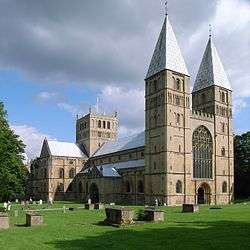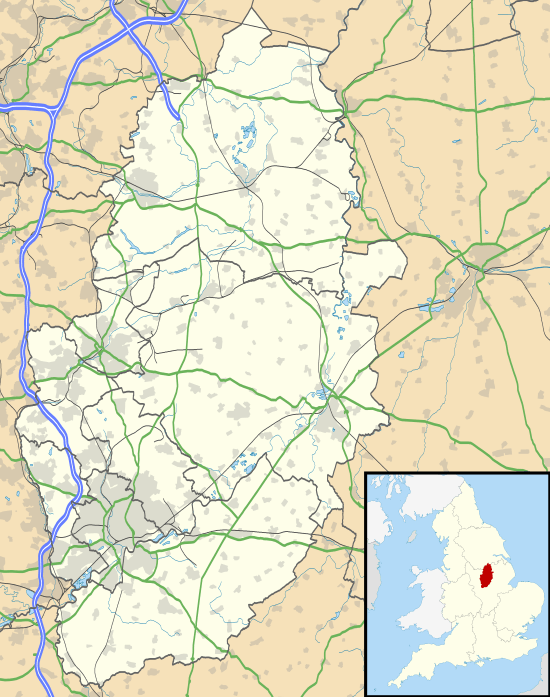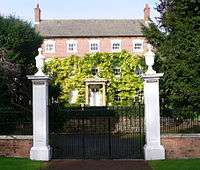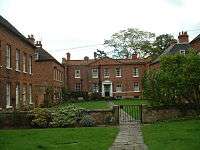Southwell, Nottinghamshire
Southwell (/ˈsaʊθwɛl, ˈsʌðəl/)[1][2] is a minster town in Nottinghamshire, England, the site of Southwell Minster, the cathedral of the Anglican Diocese of Southwell and Nottingham. A population of under 7,000 rose to 7,297 at the 2011 Census.[3] The origin of the name is unclear. It lies on the River Greet, about 14 miles (22 km) north-east of Nottingham. Other historic buildings include prebendal houses in Church Street and Westgate and the Methodist church, which has a right of way beneath it, so that the upper floor seats more than the lower. The workhouse (1824) was a prototype for many others. Owned by the National Trust, it shows its appearance in the 19th century. Behind the Minster is a partly ruined palace, once a residence of the Archbishop of York. It includes the recently restored State Chamber, Cardinal Wolsey's former dining room, and gardens among the ruins.[4]
| Southwell | |
|---|---|
 Southwell Minster | |
 Southwell Location within Nottinghamshire | |
| Population | 7,297 (2011) |
| OS grid reference | SK 69996 53962 |
| District | |
| Shire county | |
| Region | |
| Country | England |
| Sovereign state | United Kingdom |
| Post town | Southwell |
| Postcode district | NG25 |
| Dialling code | 01636 |
| Police | Nottinghamshire |
| Fire | Nottinghamshire |
| Ambulance | East Midlands |
| UK Parliament | |
Toponomy
The origin of the name is unclear. Several sites claim to be the original "well", notably at GR SK708535 where a plaque has been placed; in the Admiral Rodney pub; on the south side of the Minster, known as Lady Well in the 19th century; and one by the cloisters called Holy Well. Norwell, eight miles north-west, may support the idea of a pair of "south" and "north" wells.
Early history
The remains of an opulent Roman villa were excavated beneath the Minster and its churchyard in 1959.[5] Part of a mural from the excavation is displayed in the Minster. It is one of three of its type found in the territories of the Corieltauvi (or Coritani) tribes – along with Scampton in Lincolnshire and Norfolk Street in Leicestershire. A stretch of the Fosse Way runs on the far bank of the River Trent, with evidence of Roman settlement at Ad Pontem ("to the bridge" or "at the bridge"), north-west of the village of East Stoke. There is no clear evidence of a road between Ad Pontem and Southwell. Other evidence of Roman settlement includes the use of Roman bricks in prebendary buildings around the Minster, remains of a ditch or fosse discovered at Burgage Hill in the 19th century, and possible Roman remains beneath the Church Street site of the recently vacated Minster School.
The Venerable Bede records a multiple baptism in the "flood of the Trent" near "Tiovulginacester" by Paulinus in the presence of Edwin of Northumbria, whom he had converted to Christianity in 627. There is disagreement on the location of Tiovulginacester, but Paulinus certainly visited it and may have founded the first church in Southwell.[6]
Remains of Eadburh, Abbess of Repton and daughter of Ealdwulf of East Anglia were buried in Southwell's Saxon church.[7] Eadburh was appointed Abbess under the patronage of King Wulfhere of Mercia. She appears in the Life of Guthlac and is thought to have died about AD 700. Her remains were buried or translated to Southwell Minster, and revered there in the Middle Ages. The only reference is in a Pilgrims Guide to Shrines and Burial Places of the Saints of England supposedly written in 1000: "There resteth St. Eadburh in the Minster of Southwell near the water called the Trent."
Eadwy of England gave land in Southwell to Oskytel, Archbishop of York, in 956. This charter makes the first dated reference to Southwell. A tessellated floor and the 11th-century tympanum over a doorway in the north transept are evidence of construction of the Minster after this time. The Domesday Book (1086) has much detail of an Archbishop's manor in Southwell.
A custom known as the "Gate to Southwell" originated after 1109, when the Archbishop of York, Thomas I, wrote to each Nottinghamshire parish for contributions to building of a new mother church. Annually at Whitsuntide, the resulting "Southwell Pence" were taken to the Minster in a procession from Nottingham, headed by the Mayor and followed by clergy and lay people bound for Southwell's Whitsun Fair. The Pence were paid at the Minster's north porch to the Chapter Clerk. The "gate" in the name of Southwell Gate means "street", as in many East Midland and North-Eastern street names. The custom in its original form persisted well into the 16th century. It was revived in 1981 by the Dolphin Morrismen, but imposition of traffic-management costs forced the organisers to abandon it in 2014.[8]. It is survived by the Gate to Southwell Festival,[9] a broad musical event held every early June since 2007 on a site near Southwell and at various venues in the town.
Geoffrey Plantagenet was ordained a priest at Southwell in 1189. On 4 April 1194, Richard I and the King of Scots, William I, were in Southwell, having spent Palm Sunday in Clipstone. King John visited Southwell between 1207 and 1213, ostensibly to hunt in Sherwood Forest, but also on the way to expedition to Wales in 1212.
1300–1800
The Saracen's Head was built in 1463 on land gifted in 1396 by Archbishop Thomas Arundel of York to John and Margaret Fysher. When built, the first floor overhung the roadway in the style of the time.
In 1603, James VI of Scotland passed through Southwell on his way to London to be crowned King James I.[10]
In the English Civil War, King Charles I spent his last night as a free man in May 1646 in the Saracen's Head (then the King's Head), before surrendering to the Scottish Army stationed at nearby Kelham. The town, the Minster and the Archbishop's Palace suffered under Oliver Cromwell's troops, as they sequestered the palace to stable their horses, broke monuments, and ransacked graves for lead and other valuables. In 1793, there were still iron rings in the walls to secure the horses. By end of the war the Archbishop's Palace was in ruins apart from its Great Hall. It is reputed that Cromwell also stayed at the King's Head.
A Bridewell built on the Burgage in 1656 was enlarged in 1787 to become a county prison. There is evidence that a house of correction was built in 1611, so that the Bridewell may itself have been an enlargement. Mary Ann Brailsford of apple fame (see below) was baptised at Southwell in May 1791, and Matthew Bramley in 1796 in Balderton.
19th century and later
By 1801 the population was 2,305. In 1803, Lord Byron stayed with his mother in Burgage Manor during holidays from Harrow and Cambridge. His mother rented the house. By that time he had become 6th Baron Byron of Rochdale, but the family home, Newstead Abbey, still required repairs, which they could not afford.
Southwell today
As the site of an Anglican cathedral, the town is sometimes taken as a city and was treated as such in the 1911 Encyclopædia Britannica. However, its city status is not recognised by the government. Southwell has an active Town Council.[11]
The town is something of an oddity in North Nottinghamshire, being visibly affluent compared with neighbouring Newark-on-Trent and Mansfield. Agriculture and coal have seen the fortunes of the other two fluctuate over the years, while Southwell has remained a place where wealthier Nottinghamians like to reside.[12][13] It appeared in the Sunday Times shortlist of Best Places to Live 2017 for the Midlands region.[14]
In most of Nottinghamshire, Southwell is pronounced SUH-thull, with a voiced "th" and a silent "w". Southwell's own residents tend to pronounce it as it is spelt.
The Town Council, since the 2019 elections, consists of eight Liberal Democrat councillors, four Conservatives and two Independents. The Council Chair in 2019–2021 is Mrs Lyn Harris [Lib Dem], the Chair of the Operations Committee is Peter Harris [Lib Dem] and the Chair of Finance and Scrutiny Committee is Paul Handley [Con].[15]
The town's two infant schools (aged 3–5) are Southwell Holy Trinity C of E and Lowes Wong .[16] The latter also teaches children aged 7–11. The local secondary school is Southwell Minster School,[17] which also educates the choristers of the Minster and gifted musicians in its Junior Department. It has particularly good GCSE and AS/A level results for Nottinghamshire.[18]

The well-known Bramley cooking apple was first seeded in Southwell, by Mary Ann Brailsford in 1809.[19] Henry Merryweather, a local nurseryman then 17 years old, saw its potential and cultivated it from cuttings.[20][21] The apple is now widely used and renowned for its acidic taste and for cooking into a smooth purée. One local football club, Southwell City, is nicknamed "The Bramleys", and the town's new library and youth centre are termed the Bramley Centre. In March 2009, a stained-glass window was installed in Southwell Minister marking the apple's 200th anniversary.[22]
The local community newspaper is The Bramley".[23]; 11,200 copies are delivered monthly in and around Southwell.
Sports clubs include Southwell Rugby Club [24] (known as the Redmen), formed in 1922–1923. In the 2011–2012 season, it won a historic treble as RFU Midlands 4 (East) North League Champions, Nottinghamshire Junior Cup winners and Nottinghamshire/Lincolnshire/Derbyshire Plate winners. There is also a Southwell Cricket Club. Southwell City Football Club,[25], an FA Charter Standard Community Club, involves over 400 local players in 35 teams aged five years to veteran.
Southwell has a leisure centre run by a local trust,[26] with trustees from the community, although the district council also provides limited support.
The annual Southwell Music Festival is held every August in Southwell Minster and other nearby venues.[27] The Gate to Southwell Festival of roots and acoustic music is held each year in early June.[28]
Southwell Racecourse, owned by the Arena Racing Company, is situated on the outskirts of the town near Fiskerton and has an all-weather track. It hosts jump and flat racing.
The town is linked to Newark and Nottingham by the A612, although this has now been downgraded to a C road, and to north Nottingham and villages to the west by B6386. The A617 primary route passes 2 miles north of the town in Hockerton, and the A1 and A46 trunk routes are 7 miles away in Newark. The railway station at the nearby village of Fiskerton has gained a small car park in recent years to cater for Southwell commuters. Southwell is also served by Nottingham City Transport's rural Pathfinder 26 service to Nottingham and Stagecoach East Midlands (Mansfield) service to Mansfield and Newark.[29] There are other infrequent services to nearby villages.

The town is twinned with Sées in France and Český Brod in the Czech Republic.[30]
Notable people
In order of birth:
- St Edburga of Repton was translated from Repton Abbey to Southwell and died here about AD 700.
- Ælfric Puttoc (died 1051), Archbishop of York, died here.
- Geoffrey Plantagenet, natural son of King Henry II of England and Archbishop of York, was ordained priest here in 1181.
- Matthew Sylvester (c. 1636–1708), Nonconformist minister and religious writer, was born here.
- Thomas Spofforth (1743–1826), organist, died here.
- John Spray (c. 1768–1827), tenor singer and vicar choral for the Dublin cathedrals, was born here and sang as a boy in the Minster Choir.
- Reginald Spofforth (1769–1827), composer and organist, was baptised here.
- Mary Anne Brailsford, who grew the first Bramley cooking apple tree from seed, was baptised here in May 1791.[31]
- Rev. John Thomas Becher (1770–1848), cleric, social reformer and friend of Lord Byron, was Vicar-General of Southwell Minster in 1818–1840.
- Richard Ingleman (1777–1838), architect and surveyor, died here.
- Henry Stenton (1815–1887) was a first-class cricketer and Southwell solicitor.
- Francis Tinley (1819–1889), first-class cricketer with Nottinghamshire, was born here, as was his first-class cricketing brother Vincent Tinley (1828–1899).
- Chappell Batchelor (1822–1884), organist and first-class cricketer, was born here and sang as a boy in the Minster Choir.
- John Hatfield (1831–1889), first-class cricketer, was born here.
- William Horsley (1835–1864), first-class cricketer, was born and died here.
- Sebastian Smith (1869–1948), a stage and film actor, was born here.
- Edmond Foljambe (1890–1960), first-class cricketer, was born here.
- Ted Hufton (1892–1967), international footballer, was born here.
- Sir Joseph Lockwood (1904–1991), whose company helped to finance The Beatles, was born here.
- Lilian Greenwood (born 1966), Labour MP for Nottingham South, lived in Southwell 1999–2020.
- Robert Edward Jenrick (born 1982), Conservative MP for Newark since 2014, rents a property here.
- Scott Loach (born 1988), League footballer, attended Southwell Minster School and played for Southwell United as a youth.
Transport links
Bus services
| Bus operator | Route number | Destination(s) | Notes |
|---|---|---|---|
| Nottingham City Transport | 26:Pathfinder | Nottingham - Carlton - Burton Joyce - Lowdham - Southwell | [32] |
| Stagecoach East Midlands | 28 | Mansfield - Rainworth - Southwell - Newark | [33] |
| 29 | Southwell - Newark | ||
| Travelwright | 3 | Lowdham - Southwell - Newark | [34] |
| 227 | Newark - Southwell - Bilsthorpe - Edwinstowe | Wednesday & Friday only. [35][36] | |
| Sherwood Countryman Buses | CM2 | Maplebeck - Eakring - Kirklington - Southwell | |
| Disused bus routes | |||
| Veolia Transport | D3 | Nottingham - Arnold - Lambley - Southwell - Newark | Service sold to Premiere[37] |
| Premiere | S9 | Southwell - Lowdham - Burton Joyce - Victoria Park | Premiere was liquidated on 25 January 2013[37] |
Railway station
Southwell had a passenger railway station from 1847 to 1959. Goods traffic continued until 1964.
Education
Secondary education in the town is predominantly provided by Southwell Minster School, which still educates choristers of Southwell Minster. The Minster School is a Specialist College for Humanities and Music and was rated outstanding by Ofsted in 2011/2012.[38] Pupils may also choose to attend school at Newark-on-Trent, which is about a 20-minute drive east. The School of Animal, Rural and Environmental Sciences is part of Nottingham Trent University.[39] and offers further and higher education courses in agricultural-related subjects at its Brackenhurst campus just outside Southwell.
See also
- Dumble – a local word used to refer to a small wooded area
- Hockerwood – a historic deer park in the area
- The Workhouse, Southwell – the former parish workhouse; a prototype for many round the country, and now a National Trust property
References
- McCartney, David (24 August 2005). "South Well or Suthell?". Voices 2005. BBC Nottingham. Retrieved 5 March 2010.
- Wells, John C. (1990). Longman Pronunciation Dictionary. Harlow: Longman. ISBN 0-582-05383-8.
- "Town population 2011". Neighbourhood Statistics. Office for National Statistics. Retrieved 10 April 2016.
- Retrieved 16 November 2017.
- Daniels, C. M., "Excavations on the site of the Roman Villa in Southwell, 1959", Transactions of the Thoroton Society of Nottinghamshire, Vol. 70, 1966, pp. 13–33.
- Nottinghamshire History. Retrieved 31 May 2020.
- D. W. Rollason, "List of Saints' Resting Places in Anglo-Saxon England", Anglo-Saxon England 7, 1978, p. 89.
- Bee, Fee. "The Gate to Southwell Procession". Retrieved 4 April 2019.
- "Gate to Southwell Festival". GTSF. Retrieved 4 April 2019.
- T. Bailey, Annals of Nottinghamshire: History of the County of Nottingham, including the Borough, Vol 2 (1853), p. 544.
- .
- .
- .
- .
- .
- BBC News.
- J. Martin (2004), "Brailsford, Mary Ann", Oxford Dictionary of National Biography, Oxford: OUP, Vol. 7, p. 289.
- http://www.bramleyapples.co.uk/cooking_apples.html Archived 10 October 2010 at the Wayback Machine bramleyapples.co.uk
- Merryweather, Roger, 1982, The Bramley: A World Famous Cooking Apple, Newark and Sherwood D.C., Nottinghamshire.
- .
- The Bramley.
- Southwell Rugby Club.
- Southwell City Football Club.
- .
- "About – Southwell Music Festival". Southwell Music Festival. Retrieved 9 November 2018.
- "Gate to Southwell Festival". GTSF. Retrieved 4 April 2019.
- .
- "Archived copy". Archived from the original on 12 January 2005. Retrieved 14 February 2010.CS1 maint: archived copy as title (link)
- Retrieved 4 July 2020.
- "Nottingham City Transport 'Pathfinder'". Retrieved 28 February 2013.
- "Nottinghamshire county Council - Bus Timetable". Retrieved 28 February 2013.
- "Nottinghamshire county Council - Bus Timetable". Archived from the original on 27 September 2011. Retrieved 28 February 2013.
- "Travelwrihgt Ltd". Archived from the original on 20 February 2013. Retrieved 28 February 2013.
- "Nottinghamshire county Council - Bus Timetable". Archived from the original on 21 November 2008. Retrieved 28 February 2013.
- "BBC News". BBC News. Retrieved 2 March 2013.
- .
- School of Animal, Rural and Environmental Sciences
Further references
- Betty M. Arundel, Southwell - A History Walk, The Southwell Civic Society, 2001
- F. R. Barry, Period of my Life (Bishop of Southwell)", Hodder & Stoughton, 1970
- R. M. Beaumont, A Flash of Lightning on Guy Fawkes Night, 1711: The Fire at Southwell Minster, The Thoroton Society, 1973
- R. M. Beaumont, The Chapter of Southwell Minster, a Story of 1,000 years, 1956
- M. Bishop, An Archaeological Resource Assessment of Roman Nottinghamshire, EMARF, n. d.
- M. Boyes, Love without wings: The story of the unique relationship between Elizabeth Bridget Pigot of Southwell and the young poet, Lord Byron, J. M. Tatler & Son, 1988
- J. Buckler, The Collegiate Church of Saint Mary, Southwell, Bermondsey, 1810
- T. H. Clark, The History and Antiquities of Southwell Collegiate Church, J. Whittingham, 1838
- Roger Dobson, Southwell Inns and Alehouses, Nottinghamshire County Council, 2008
External links
| Wikimedia Commons has media related to Southwell, Nottinghamshire. |